Although most of the vegetation has been cleared to avoid a complete decay, the temple remains covered under the shadowy green canopy of beautiful silk-cotton trees that give to the visitor fantastic views of tall pale trunks rising over the ruins and long snaking roots through fallen stones. Ta Prohm is a royal monastery built by the great Buddhist monarch Jayavarman VII, the temple used to house Prajnaparamita the Perfection of Wisdom, a female aspect of a bodhisattva's personality (paramita).
Of a flat plan style, the temple as such consists of three concentric galleries immersed in a forested area and enclosed by two successive rings of laterite walls.
Ta Prohm |
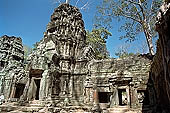
|
Entering the site from west, we cross the most external wall trough a gopura, its tower has four faces of Lokesvara in the Bayon style. From here a track through the forest leads to the temple ruins.
At first we find a terraced causeway that crossing a moat leads to the badly ruined gopura of the third enclosure gallery, its walls are abundantly decorated with devatas. The third enclosure is a corbelled gallery with the interior wall decorated with Buddhist images sheltered in shallow niches which have been systematically destroyed during the Hindus reaction of the xiii century.
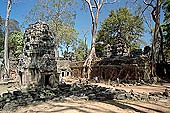
|
Ta Prohm
|
Crossing the gallery we find our self in the south-west right-angled courtyard within the third and second enclosure. The laterite and sandstone wall of the second enclosure grasped by tree roots. From the courtyard, through a small door we cross the second enclosure.
Inside the central sanctuary, with its towers and galleries, is left almost in a shapeless mass of ruins. We admire devatas sculpted on the gallery walls and a door entirely framed by the roots of a gigantic tree.
Ta Prohm |
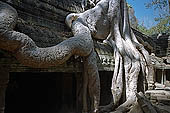
|
Heading east we cross again the second gallery and we find ourselves in the eastern courtyard of the third enclosure, with several isolated sanctuary towers.
Passing through a narrow opening one crosses the third gallery, here a tall tree envelopes symmetrically with its roots the jamb stones of the gopura entrance.
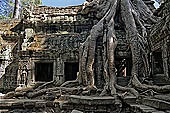
|
Ta Prohm
|
One arrives at the imposing eastern gopura of the fourth enclosure decorated with remarkable bas-reliefs and partly clutched by gigantic roots. Another relief, from the entrance gopura, depicts the Temptation of Mara, the Buddha figure has been erased
while, on either sides, the Mara's Army is still visible.
The moats are crossed by a slightly raised vast terrace decorated with lions and naga-balustrades.
Ta Prohm |
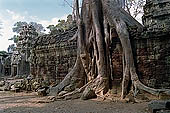
|
Within the main temple and the outermost enclosure there is a typical shelter for pilgrims usually referred as ‘dharmasala’.
A path leads towards the east to the last enclosure (the fifth) its ruined gopura is similar to the one encountered on the west entrance.
|
|
|



